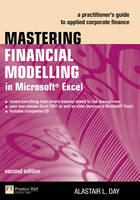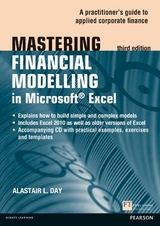
Mastering Financial Modelling in Microsoft Excel
Financial Times Prentice Hall
978-0-273-70806-3 (ISBN)
- Titel erscheint in neuer Auflage
- Artikel merken
With every major choice we face we "run through the numbers" to guide our decision-making and legitimise the outcomes. Financial modelling helps managers to make more informed decisions and, crucially, win corporate commitment for those decisions. The ability to construct useful financial models with speed and accuracy is becoming a key skill for all executives to master.
However, this is a skill few managers and businesses know how to develop. For the busy executive or finance officer, an Excel user-manual is no place to start - today's financial models have moved a long way from the original single-sheet spreadsheets that most of us feel comfortable manipulating. Modern spreadsheets allow advanced managers to adopt advanced decision-making and analysis tools, but few have time or programming skills to use the spreadsheets to the full. This book will show managers how they can extend their decision-making capabilities by mastering the use and abuse of financial models.
This is the ultimate book and disk combination that will help finance professionals and business students alike to become more proficient in building Microsoft Excel models and applying corporate finance concepts.
The Mastering Series
are your practical guides to gaining the knowledge you need to succeed in the financial world. With the very latest practical examples, exercises and templates used throughout for ease of understanding, The Mastering Series covers every aspect of the topic from the basic essential skills you need to perform your job effectively to the more advanced skills to get you to the top. Written by practitioners for practitioners, these books give you just what you need - and nothing more - to succeed in finance. Several of the titles also come with companion CDs to allow you to put the book's ideas into action straightaway.
The Mastering Series: Practical, comprehensive, essential.
Alastair Day has worked in the finance industry for 20 years in treasury and marketing functions. He is an associate lecturer in corporate finance with the OUBS, and other publications include books such as The Financial Director's Guide to Purchasing Leasing.
Contents
Introduction who needs this book?
Preface to the second edition
Acknowledgements
Conventions
Executive summary
Part A DEVELOPING FINANCIAL MODELS
1 Overview
Introduction
What is financial modelling?
History of spreadsheets
Power of spreadsheets
Objectives for the book
Example spreadsheet
Summary
2 Design introduction
Introduction
Basics of design
Objectives
User interface
Key variables and rules
Layout
Individual modules
Menu structure and macros
Management reporting
Future development
Testing
Protection
Documentation
Peer group comments
Summary
3 Features and techniques
Introduction
Formats
Number format
Lines and borders
Colours and patterns
Specific colours for inputs and results
Data validation
Controls combo boxes and buttons
Conditional formatting
Use of functions and types of function
Add-ins for more functions
Text and updated labels
Record a version number, author, etc.
Use names to make formulas easier to understand
Paste names as part of documentation
Comment cells
Graphics
Dynamic graphs to plot individual series
Data tables
Scenarios
Goal seek
Solver
Use of templates
Summary
4 Sample model
Introduction
Aims and objectives
User needs and user interface
Key variables and rules
Breaking down the calculations into manageable groups
Setting up individual modules
Menu structure
Program sheets and macros
User assistance
Summaries
Risk and multiple answers
Testing and troubleshooting
Protecting and securing
Help and documentation
Show to peers take their advice
Control loop listen, learn and modify
Summary
5 Example model
Introduction
Case study
Design
PPP 1
PPP 2
PPP 3
PPP 4
PPP 5
Documenting, testing and protecting
PPP 6
Summary
Part B APPLICATIONS
6 Analysing performance
Introduction
Profit and loss
Balance sheet
Ratios
Trend analysis
Sustainability
Summary
7 Cash flow
Deriving cash flow
Net operating cash flow (NOCF)
Free cash flow
Cover ratios
International cash flow
Summary
8 Forecasting models
Introduction
Historic forecasts
Trend lines
Trend lines for analysis
Data smoothing
Cyclicality and seasonality
Summary
9 Forecasting financials
Introduction
Key drivers
Deriving financial statements
Alternative approaches
Financial analysis
Summary
10 Variance analysis
Introduction
Cash flow budgets
Monthly cash model
'Flash' report and graphics
Summary
11 Breakeven analysis
Introduction
Breakeven
Operating leverage
Financial leverage
Combined leverage
Summary
12 Portfolio analysis
Introduction
Formulas
Optimum portfolio
13 Cost of capital
Introduction
Capital Asset Pricing Model
Dividend growth model
Cost of preference shares
Cost of debt
Weighted average cost of capital
Marginal WACC
Summary
14 Bonds
Introduction
Cash flows
Yield measures
Duration
Portfolio results
Summary
15 Investment analysis
Introduction
Investment model revisited
Payback period
Accounting return
Net present value
Internal rate of return
Benefit/cost ratio
Management tests cash flow, etc.
Scenarios
Sensitivity analysis and charts
Capital rationing
Summary
16 Risk Analysis
Introduction
Risk assessment process and analysis
Risk adjusted rate iation
Coefficient of variation
Certainty equivalents
Real options
Simulation
Summary
17 Depreciation
Introduction
Straight line
Sum of digits
Declining balance
US MACRS
Amortisation
Comparison
Summary
18 Leasing
Introduction
Rental calculations
Lease versus purchase
Classification
Accounting
Settlements
Summary
19 Company valuation
Introduction
Accounts
Adjusted accounting value
Dividends
Stock market or market method
Free cash flows
Summary
20 Optimisation
Introduction
Elements of optimisation models
Linear programming
Margin maximisation
Pensions
Summary
21 Decision trees
Introduction
Bayes' theorem
Terminology
Decision tree model
Information example
Summary
22 Risk management
Introduction
Forward rate agreements
Swaps
Foreign exchange
Futures
Options
Black-Scholes
Summary
23 Data functions
Introduction
Dataset
Database functions
Descriptive statistics
Histogram
Function output
Box plots
Summary
24 Data analysis
Introduction
Imported data
Sort
Filter
Subtotals
Pivot table and chart
Database import
Radar chart
Gauge chart
Summary
25 Modelling checklist
Introduction
Design summary
Features
Techniques
Appendices
Appendix 1: Software installation
Appendix 2: Licence
Appendix 3: File list
Appendix 4: Microsoft Office 2007 (Office 12)
Bibliography and references
Index
| Erscheint lt. Verlag | 17.4.2007 |
|---|---|
| Reihe/Serie | Financial Times Series |
| Verlagsort | Harlow |
| Sprache | englisch |
| Maße | 238 x 175 mm |
| Gewicht | 898 g |
| Themenwelt | Informatik ► Office Programme ► Excel |
| Mathematik / Informatik ► Mathematik ► Finanz- / Wirtschaftsmathematik | |
| Wirtschaft ► Betriebswirtschaft / Management ► Finanzierung | |
| ISBN-10 | 0-273-70806-6 / 0273708066 |
| ISBN-13 | 978-0-273-70806-3 / 9780273708063 |
| Zustand | Neuware |
| Haben Sie eine Frage zum Produkt? |
